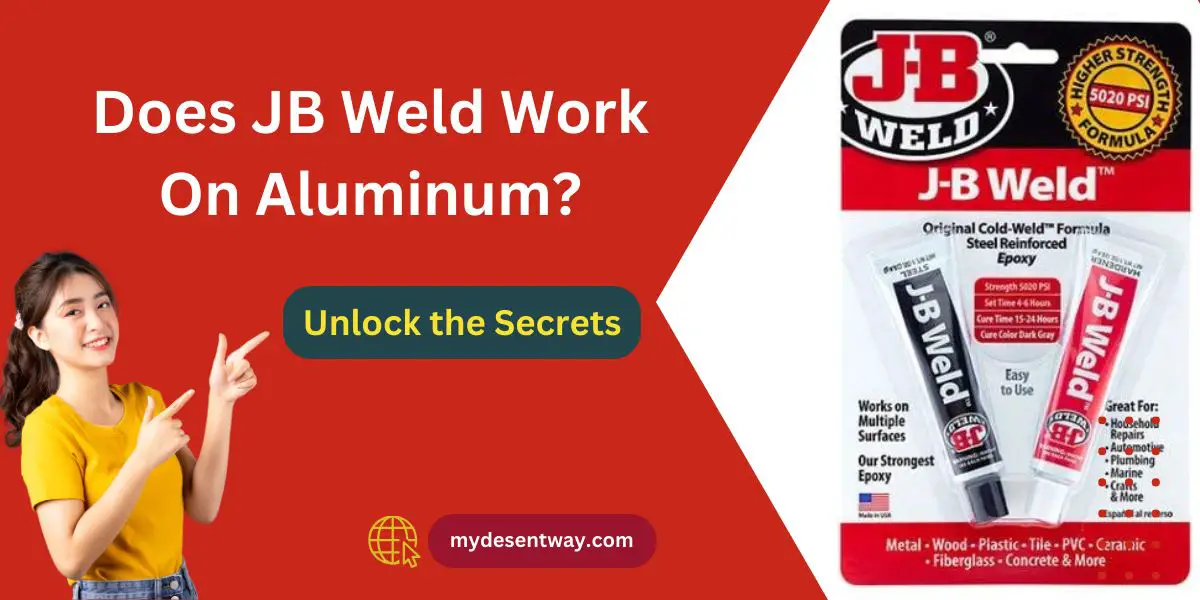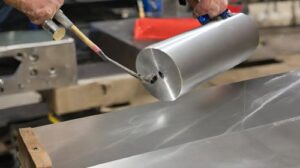Table of Contents
- Importance and Feasibility
- Does JB Weld Work on Aluminum?
- Efficiency and Effectiveness on Aluminum
- Using JB Weld on Aluminum: Practical Guidelines
- Optimizing JB Weld Application for Aluminum Repairs
- Application Techniques and Considerations
- Specific JB Weld Products for Aluminum
- Conclusion and Recommendations
- Summary of JB Weld’s Performance on Aluminum
- FAQs
- Is JB Weld suitable for aluminum repairs?
- What factors affect JB Weld’s effectiveness on aluminum?
- Can JB Weld create a strong bond on aluminum?
- Which JB Weld variant is best for aluminum repairs?
- How crucial is surface preparation for JB Weld on aluminum?
Aluminum repairs often pose a challenge, demanding a reliable solution. Amidst various options, JB Weld emerges as a potential fix. But Does JB Weld Work On Aluminum Surfaces? This article delves into the efficiency, application techniques, and recommended products of JB Weld specifically tailored for aluminum repairs. Uncover the truth behind JB Weld’s compatibility with aluminum and discover practical insights for successful maintenance.
Importance and Feasibility
Aluminum, while favored for its lightweight and corrosion-resistant properties, poses unique challenges regarding repairs. Traditional methods may fall short of providing a reliable and lasting fix. Enter JB Weld – a versatile epoxy adhesive that has gained prominence in the world of repairs.
JB Weld offers a promising solution for aluminum repairs, promising a solid and resilient bond that withstands the test of time. Its importance lies in its ability to bridge gaps, fill voids, and create robust connections on various materials, including aluminum. Whether dealing with a cracked aluminum engine part, a broken aluminum tool, or any other aluminum-based repair, JB Weld is a feasible option.
Addressing the Use of JB Weld on Aluminum
Before delving into the specifics, it’s essential to address the question: Can JB Weld be effectively used on aluminum surfaces? This article aims to provide a comprehensive answer by exploring the compatibility, efficiency, and best practices associated with using JB Weld on aluminum.
In DIY repairs, JB Weld has gained a reputation for its versatility, allowing users to tackle many fixes. However, aluminum’s distinct characteristics necessitate a closer examination of JB Weld’s performance in this context.
As we navigate the intricacies of using JB Weld’s work on aluminum, we’ll uncover insights beyond a simple “yes” or “no” response. The nuances of surface preparation, application techniques, and selecting the suitable JB Weld variant for aluminum repairs will be dissected to provide a thorough understanding. By the end of this exploration, you’ll be equipped with the knowledge needed to make informed decisions when contemplating JB Weld for your aluminum repair projects.
Does JB Weld Work on Aluminum?
Yes, JB Weld is compatible with aluminum surfaces. It’s formulated to adhere well to various materials, including aluminum, making it suitable for bonding or repairing aluminum parts and surfaces. Proper surface preparation and following the instructions provided with the product are essential for achieving a solid and durable bond.
Is JB Weld Strong on Aluminum?
The strength of JB Weld on aluminum is another aspect that demands attention. JB Weld forms a robust and durable bond on aluminum surfaces when applied correctly and under suitable conditions.
The strength largely depends on factors like:
- Proper surface cleaning and preparation
- Adherence to recommended application procedures
- Choosing the right JB Weld variant designed for aluminum repairs
Understanding the limitations and strengths of JB Weld on aluminum surfaces is vital for ensuring reliable and lasting repairs. Evaluating its performance and adherence to best practices enhances the likelihood of successful outcomes when working with aluminum.
Efficiency and Effectiveness on Aluminum
JB Weld’s performance on aluminum surfaces is pivotal in determining its repair efficacy.
Testing and Evaluation of JB Weld on Aluminum
Various tests and evaluations have been conducted to ascertain JB Weld’s efficiency on aluminum. These assessments often focus on:
- Bond Strength: Measuring the adhesive strength of JB Weld on aluminum under different conditions.
- Durability: Assessing how well the bond withstands environmental factors and stress over time.
- Compatibility: Exploring the adaptability of JB Weld with different grades and forms of aluminum.
These tests provide valuable insights into JB Weld’s performance on aluminum, aiding in understanding its limitations and strengths in real-world repair scenarios.
Comparing Different JB Weld Products for Aluminum
Not all JB Weld variants are created equal, especially concerning aluminum repairs. Variants may differ in composition, curing time, and adhesion properties.
- Strength and Durability: Some variants might offer enhanced stability or faster curing times on aluminum surfaces.
- Application Specificity: Certain variants may be designed explicitly for aluminum repairs, providing optimal performance and durability.
Users can make informed decisions about the most suitable variant for their specific repair needs by comparing and contrasting various JB Weld products tailored for aluminum repairs.
Using JB Weld on Aluminum: Practical Guidelines
Applying JB Weld effectively on aluminum surfaces requires adherence to specific guidelines and techniques for successful outcomes.
How to Use JB Weld on Aluminum Surfaces
- Surface Preparation: Cleaning the aluminum surface is crucial. Remove dirt, oil, and any residue thoroughly to ensure proper adhesion. Sanding or roughening the surface can enhance bond strength.
- Mixing JB Weld: Follow the manufacturer’s instructions meticulously. Correctly mixing the epoxy and hardener ensures optimal bonding properties.
- Application Techniques: Apply JB Weld evenly and generously on the prepared aluminum surface. Utilize tools or applicators suitable for the repair area to ensure uniform coverage.
Preparing Aluminum Surfaces for JB Weld Application
- Cleaning: Use a suitable cleaner or solvent to remove grease, oil, and debris from the aluminum surface. Ensure it’s scorched before applying JB Weld.
- Surface Roughening: Sand the surface lightly to create a better bonding surface for JB Weld. This step enhances the mechanical adhesion between JB Weld and aluminum.
Adhering to these guidelines enhances the chances of a successful bond between JB Weld and aluminum, optimizing the repair’s strength and durability. Failure to follow these steps meticulously might compromise the efficacy of the repair.
Optimizing JB Weld Application for Aluminum Repairs
Optimizing the application process is essential for successful repairs using JB Weld on aluminum. Here are practical insights and strategies to achieve reliable outcomes:
Tips and Tricks for Successful Application on Aluminum
- Temperature Considerations: Maintain a suitable temperature range during application and curing. Extreme temperatures can affect JB Weld’s performance.
- Proper Mixing: Accurate mixing of the epoxy and hardener is critical. Follow the manufacturer’s instructions diligently to achieve the desired bonding strength.
- Work Time and Cure Time: Understand the work time and cure time of the JB Weld variant being used. Apply within the recommended work time, allowing sufficient curing time for optimal strength.
- Surface Preparation Precision: Thoroughly clean and roughen the aluminum surface before applying JB Weld. Any contaminants or smooth surfaces can hinder adhesion.
Choosing the Best JB Weld for Aluminum Repairs
- Variant Suitability: Different JB Weld variants cater to various repair needs. Choose a variant specifically designed for aluminum repairs for enhanced adhesion and durability.
- Strength and Durability Ratings: Consider the strength and durability ratings of different JB Weld variants on aluminum. Some may offer superior strength or quicker curing times.
By implementing these tips and choosing the appropriate JB Weld variant, users can significantly enhance the success rate of their aluminum repairs. Attention to detail during application and product selection ensures reliable and long-lasting outcomes.
Application Techniques and Considerations
Executing the application of JB Weld on aluminum surfaces requires precision and adherence to specific considerations to maximize its effectiveness:
Applying JB Weld to Aluminum Surfaces
- Even Application: Apply JB Weld evenly across the aluminum surface to ensure a uniform bond. The uneven application might result in weak spots or insufficient coverage.
- Avoid Excess Material: While generous application is encouraged, excess JB Weld can lead to drips or uneven surfaces. Aim for a sufficient layer without over-application.
- Pressure and Contact: Ensure proper contact between the JB Weld and the aluminum surface. Applying gentle pressure can aid in enhancing the bond.
Curing and Finishing JB Weld on Aluminum
- Curing Time: Respect the recommended curing time provided by the manufacturer. Avoid subjecting the repair to stress or load before fully cured to ensure optimal strength.
- Post-Curing Finishing: Consider sanding or polishing the repaired area for a smoother finish once cured. This step enhances aesthetics and may improve the overall durability of the repair.
By mastering these application techniques and post-application considerations, users can elevate the effectiveness and longevity of JB Weld repairs on aluminum surfaces. Careful attention to detail throughout the application and curing process contributes significantly to the success of the repair.
Specific JB Weld Products for Aluminum
Several JB Weld products are tailored to suit aluminum repair needs, each offering unique characteristics and benefits:
Reviewing JB Weld Products Catered to Aluminum Repairs
J-B Weld 8271 KwikWeld Professional Size
- Features: Fast-setting epoxy with high bonding strength.
- Suitability for Aluminum: Designed for quick repairs on various metals, including aluminum.
- Application: Well-suited for small-scale repairs needing rapid bonding on aluminum surfaces.
Star Brite 4 Oz Epoxy Putty Stick
- Features: Epoxy putty stick offering ease of use and versatility.
- Aluminum Compatibility: Specifically formulated for bonding and sealing aluminum surfaces.
- Application: Ideal for filling gaps, cracks, or holes in aluminum structures or components.
Comparison of Different JB Weld Variants for Aluminum
- Strength and Durability Variations: Various JB Weld products exhibit differences in bonding strength and durability, specifically on aluminum.
- Curing Time and Application Ease: Some variants might offer quicker curing times or more accessible application methods, catering to specific repair requirements.
Understanding the distinct features and performance characteristics of these JB Weld variants enables users to make informed decisions based on the specific needs of their aluminum repair projects. Choosing the most suitable product ensures optimal bonding strength, durability, and overall repair success.
Conclusion and Recommendations
After exploring the dynamics of JB Weld’s application on aluminum surfaces, several key insights emerge, paving the way for informed conclusions and recommendations:
Summary of JB Weld’s Performance on Aluminum
- Compatibility Affirmed: JB Weld demonstrates effectiveness on aluminum surfaces when proper surface preparation and application techniques are employed.
- Strength and Durability: When applied correctly, JB Weld forms strong and durable bonds on aluminum, contributing to reliable repairs.
- Product Variation Impact: Different JB Weld variants offer varying strengths, curing times, and application ease, influencing their suitability for specific aluminum repairs.
Recommendations for Effective Aluminum Repairs using JB Weld
- Surface Preparation Emphasis: Thoroughly clean and roughen aluminum surfaces before applying JB Weld for optimal adhesion.
- Variant Selection: Choose a JB Weld product tailored for aluminum repairs, considering factors like strength, curing time, and application suitability.
- Adherence to Guidelines: Follow manufacturer guidelines diligently throughout the application and curing process for best results.
Final Thoughts
JB Weld presents a viable solution for repairing aluminum surfaces, offering versatility and reliability when applied according to recommended practices. By understanding its capabilities and choosing the suitable variant for specific repair needs, users can confidently rely on JB Weld for successful and lasting aluminum repairs.
FAQs
Is JB Weld suitable for aluminum repairs?
Yes, JB Weld is suitable for repairing aluminum surfaces, offering a reliable bonding solution when applied correctly.
What factors affect JB Weld’s effectiveness on aluminum?
Surface preparation, application techniques, and the specific JB Weld variant used significantly impact its effectiveness on aluminum.
Can JB Weld create a strong bond on aluminum?
When applied following recommended procedures, JB Weld forms a strong and durable bond on aluminum surfaces.
Which JB Weld variant is best for aluminum repairs?
Variants like JB Weld 8271 KwikWeld Professional Size or epoxy putty sticks formulated for aluminum repairs are suitable options.
How crucial is surface preparation for JB Weld on aluminum?
Surface preparation is critical. Thoroughly cleaning and roughening the aluminum surface ensure optimal adhesion and bond strength for JB Weld.




3 thoughts on “Does J-B Weld Work On Aluminum?”